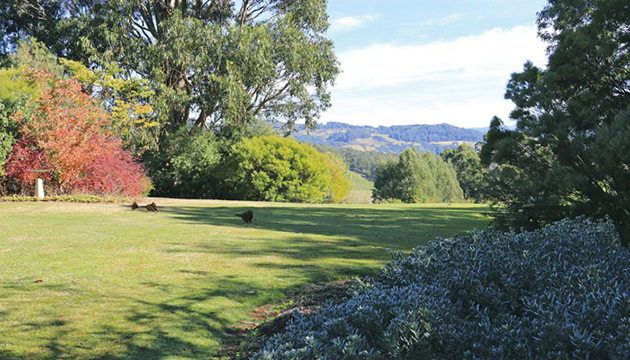Tasmanian teachers create their dream garden in the moist Huon Valley.
Story By Kim Woods Rabbidge
It took 12 months after purchasing their 1.4-hectare Huon Valley block in 1987 before teachers Peter and Robyn Marmion were able to leave northern Tasmania and establish Lane’s End – their home and garden. The picturesque valley, south of Hobart near the Southwest National Park World Heritage Area, is a magnet for artisans and those who love heritage and nature.
“We’d searched for a place where we could have a large garden with reliable rainfall,” Peter says. While waiting to relocate they’d head to the block with their young family during holidays. “We tidied it, clearing 6-metre blackberries, thistles and bracken,” he says. They also planned their garden on paper, inspired by the naturalistic approach of the influential designer Edna Walling. Mossy lawns, lichen-covered trees and rocks, and pathways through woodland add to the garden’s restful ambience.
Nearly 30 years on, and retired, the Marmions retain a passion for the place they share with furry and feathered friends. It’s an unfenced haven for wildlife, and the entomological diversity reflects a healthy ecosystem. Many mammals and reptiles live in or visit the garden. Bettongs and barred bandicoots are favourites, and at night bats awaken to forage on insects. Peter says that although they live in harmony with the wildlife, sometimes it’s difficult. “Generally the wallabies just graze on the lawn, but they do like our roses rather a lot!” he says. “We bag plants until they get established, and spread blood and bone as a deterrent.”
First light brings a cacophony of bird calls. It’s home to more than 70 bird species, including robins, flycatchers, wattlebirds, honeyeaters, pardalotes and wrens. Birds are also the theme of sculptures placed around the garden: a perch of wooden swift parrots, metallic crows swung from branches, and a family of guinea fowls poised to scuttle across the lawn all appear in suspended animation.
A multi-layered hedge helps protect the garden from regular south-western winds, but around the home open lawn areas allow vistas through to the Snowy Range and the valley floor.
This Story is from Issue #103
Outback Magazine: Oct/Nov 2015










